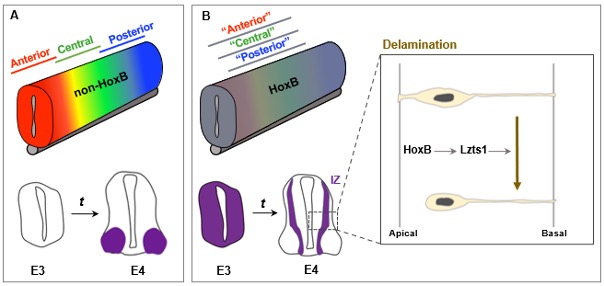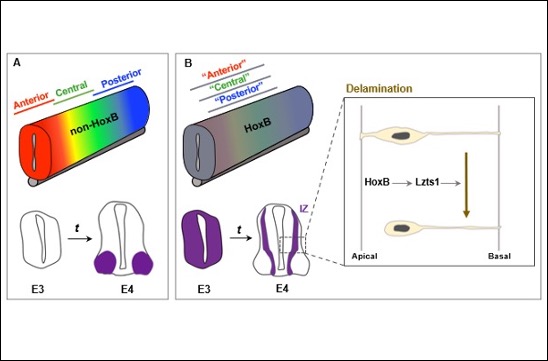The team of Yacine Graba and Andrew Saurin identified an atypical function for HoxB genes during spinal cord development: instead of setting positional information, Hox transcription factors of the B cluster control, irrespective of their paralog identity, the delamination of the neuronally differentiating cells by controlling the expression of Lzts1.
Differential Hox gene expression is central for specification of axial neuronal diversity in the spinal cord. In this study, the team of Yacine Graba and Andrew Saurin highlights an additional function for Hox proteins in the developing spinal cord, restricted to B cluster Hox genes. They found that members of the HoxB cluster are expressed in the trunk neural tube of chicken embryo earlier than Hox from other clusters, with poor antero-posterior axial specificity and with overlapping expression in the intermediate zone (IZ). Gain-of-function experiments of HoxB4, HoxB8 or HoxB9, respectively representative of anterior, central and posterior HoxB genes, resulted in ectopic progenitor cells in the mantle zone. The search for HoxB8 downstream targets in the early neural tube identified the leucine zipper tumor suppressor 1 gene (Lzts1), the expression of which is also activated by HoxB4 and HoxB9. Gain- and loss-of-function experiments showed that Lzts1, which is expressed endogenously in the IZ, controls neuronal delamination. These data collectively indicate that HoxB genes have a generic function in the developing spinal cord, controlling the expression of Lzts1 and neuronal delamination.

To know more:
Wilmerding A, Rinaldi L, Caruso N, Lo Re L, Bonzom E, Saurin AJ, Graba Y, Delfini MC.
Development. 2021 Feb 18;148(4):dev195404. doi: 10.1242/dev.195404
Contact
Marie Claire Delfini – marie-claire.delfini-farcot@univ-amu.fr
Yacine Graba – yacine.graba@univ-amu.fr




